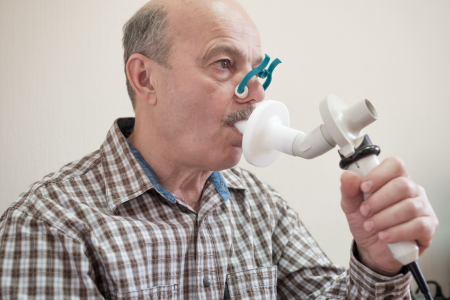
Diagnosing COPD & Stages of COPD
Your healthcare provider will consider your age, symptoms, medical history and results of a physical exam.
Diagnosing COPD
When diagnosing COPD, your healthcare provider will consider your age, symptoms, medical history and results of a physical exam. It's important that your provider orders lung function testing or spirometry to confirm a diagnosis.
The importance of spirometry
Spirometry is a simple breathing test that measures the speed and the amount of air you are able to blow out of your lungs, using a device called a spirometer. Some doctors will offer spirometry testing in their office, while others will refer you to a lab or clinic that specializes in lung testing.
It is also important that the person administering the test has proper training on the use of a spirometer and in interpreting the test results. Your results will be compared against a “reference” or expected value, based on your age, height, sex and race.
Ruling out other health issues
Your doctor may order a CT scan or chest x-ray. These tests should not be used to diagnose COPD. If a CT scan or chest x-ray shows signs of possible COPD, spirometry should be used to confirm a diagnosis. A CT scan or chest x-ray may also help rule out other causes of the symptoms you’re experiencing or to determine if you have another condition at the same time, called a comorbidity.
If you are diagnosed with COPD, your doctor will also tell you the severity of your COPD: mild, moderate, severe or very severe. When determining what medications are best for you, your provider will consider your symptoms, your spirometry results, your history of exacerbations and any comorbidities that may be affecting your respiratory health.
Stages of COPD
Mild COPD
- You may have no symptoms.
- You may have breathlessness on moderate exertion and/or recurrent chest infections.
- Your symptoms have little or no effect on daily activities.
Moderate COPD
- Your daily activities are increasingly limited.
- You have increasing breathlessness, for example when walking a short distance on level ground. You might have to stop every few minutes to catch your breath.
- Your symptoms periodically become worse, requiring corticosteroids and/or antibiotics
- You have a phlegmy or productive cough.
Severe COPD
- You feel breathless even with minimal exertion. For example, you may get breathless getting dressed.
- Your daily activities are severely limited
- You have a chronic cough and you regularly cough up mucus/phlegm.
"End-stage" or very severe COPD
- You wheeze constantly and have trouble catching your breath even when you're resting.
- You loose weight without trying.
- You may feel confused or delirious from lack of oxygen in your blood.
